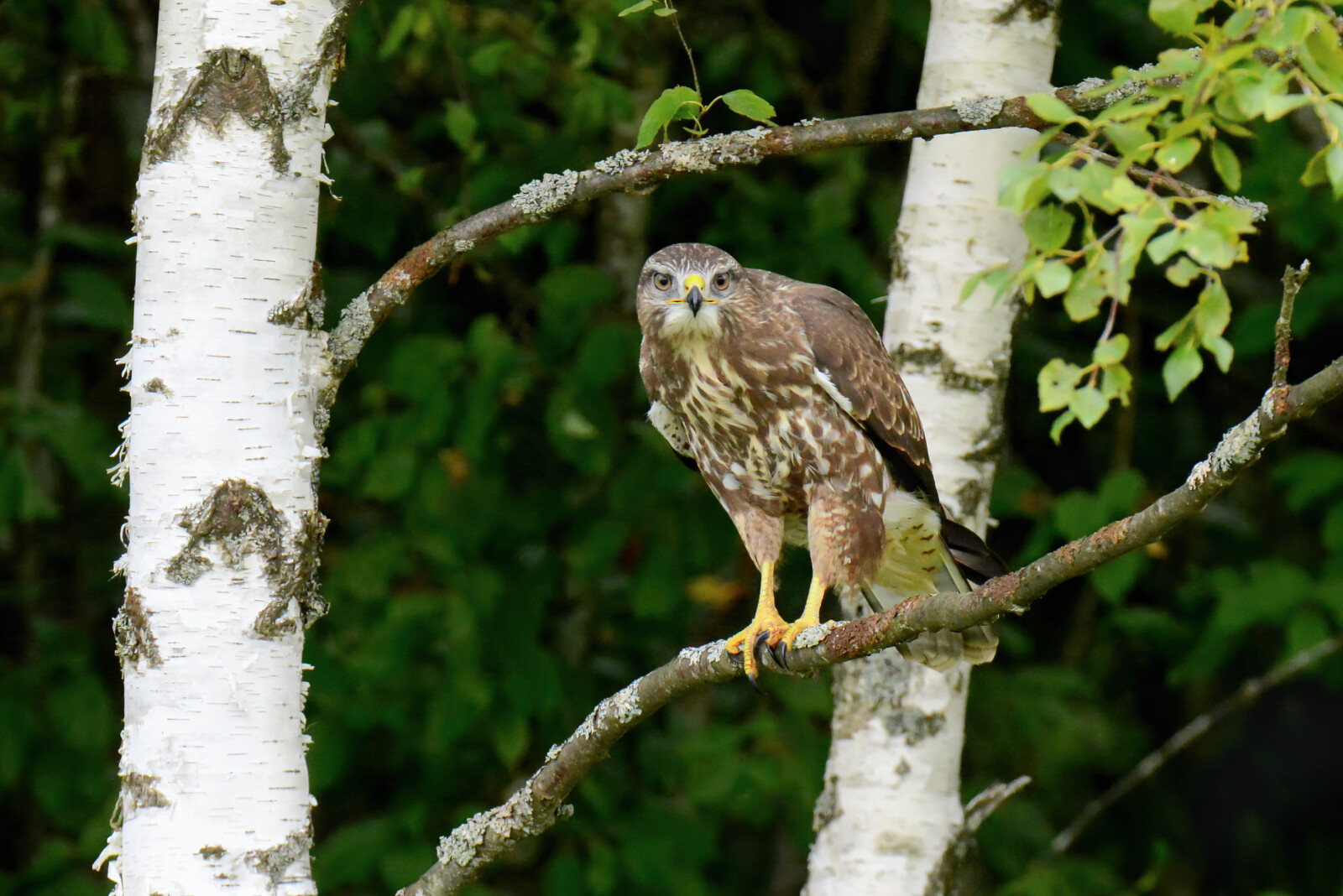Common buzzard
- Common buzzard
- https://linnuriik.ee/wp-content/uploads/2021/09/Hiireviu_PeterLind_DDD_2413a-2-s-2-1024x684.jpg
- Keemu linnud
- https://linnuriik.ee/wp-content/uploads/2021/09/hiireviu2_salvestusVRunnel.mp3
Common buzzard. Photo: Peter Lind
Introduction
Latin Buteo buteo (Glog.)
Estonian Hiireviu
Also known as: no known names
Status in Estonia
Breeding, migratory and wintering bird.
Description
The common buzzard is a raven-sized bird with rounded wings and a short tail. The colour varies, usually dark brown with a brighter underbelly. The chest has a large bright streak against dark plumage. The head is brown and the base of the beak is yellow, changing to black from the nostrils. A common buzzard’s legs have a light brown upper half and a yellowish toe area. The lower portion of the legs are featherless. Juveniles are similar to adult birds, except their breast feathers are longitudinally striped (in adult birds they are diagonally striped) and their iris is bright (in mature birds it is dark).
Size
Body length 40–48 cm, wingspan 100–125 cm. Male body mass 620–910 g, female body mass 880–1000 g.
Similar species
Rough-legged buzzard, European honey buzzard.
Distribution
The common buzzard is found throughout Eurasia’s forest and forest-steppe zones as well as Mediterranean countries, some eastern Atlantic Ocean islands and the Southern Himalayas. Only Iceland, northern Scandinavia, and Northern Russia do not have this species in Europe. In Estonia, the common buzzard is a common breeding bird everywhere.
Population
Estonia’s most numerous bird of prey, with 7000–9000 couples nesting throughout the country, including the islands. The winter population ranges between 1000–2500 birds, with northern counties having a lower population density than Southern Estonia.
Occurrence in Estonia
The common buzzard is a migratory bird that arrives here depending on how spring goes from February to April but usually in March. It leaves for wintering grounds between the end of August and the end of October. During warmer winters, many of them stay here to winter.
Diet
It feeds on small mammals, primarily mice, European water voles and other rodents as well as perching birds, young landfowl and ducks. Less frequently, it eats reptiles, amphibians, earthworms and larger insects. It also eats carrion. It hunts pray by circling silently in the air or quietly lurking somewhere higher above.
Habitat
Nests are usually found in woods or on their boundaries where there are plenty of good hunting places such as fields, meadows, flood-meadows and clearings. For hunting, it typically moves to open terrain. It is frequently spotted lurking among the trees at the forest’s border, it brown colour making it undetectable.
Nesting
The nest is normally built in a tree near a clearing, approximately 40 metres away. The nest is often built in the middle of a strong conifer tree, less often on a broad-leaf tree. It often uses abandoned nests from other bird of prey species. The common buzzard can use the same nest for years, although new branches are added to it before each breeding period. During April, 3–4 eggs are laid in the nest or 1–2 eggs on a bad year. The eggs are white with spots of rusty brown, yellow and grey. The chicks hatch towards the end of May, approximately 34 days after laying and are capable of flight by the beginning of July. The quantity of fledglings depends on nutritional conditions.
Conservation status and protection
The common buzzard belongs to the protected species of category III. Since it is afraid of disruption during egg-laying and incubating, forestry work should be avoided within 300–450 metres of an inhabited nest during the breeding season. In the past, human hostility in so-called falcon wars and the use of pesticides in agriculture posed a serious threat.
Distribution and population in Lääne County
As in other parts of Estonia, the common buzzard is the most common bird of prey in Lääne County. Common buzzards can be found lurking on power poles and at the tops of shrubs and hovering in the skies across Lääne County. They are especially common in the mosaic cultural landscape, which combines small groves with agricultural landscapes.
Common buzzards are most commonly seen between March and October, but dozens of them also stay to winter in Lääne County.
